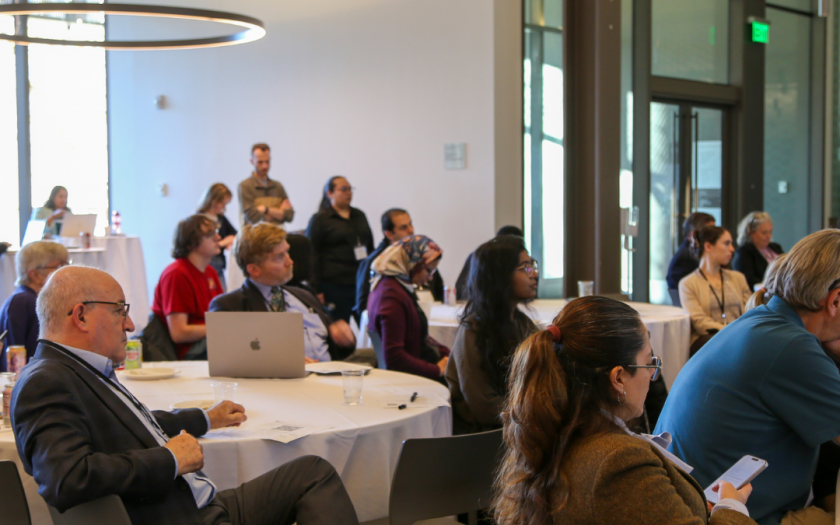Fostering Connections Between “People Who Have Different Expertise:” I-BEAM Hosts First Grand Rounds

On November 19, the Institute of Biology, Engineering, and Medicine (I-BEAM) Fall Grand Rounds offered a chance for extensive discussion on interdisciplinary collaboration. With a mix of presentations, discussions, and Q&A sessions, the inaugural Grand Rounds brought people from all corners of I-BEAM together.
Dr. Martinez Wilhelmus’ presentation embodied the spirit of the event: to an audience of students, clinicians, and faculty gathered at Brown’s Engineering Resource Center, Thomas J. and Alice M. Tisch Assistant Professor of Engineering Monica Martinez Wilhelmus shared how becoming a new mom inspired her research into the fluid mechanics behind breastfeeding. She saw gaps in research about “the physics behind breastfeeding.”
Dr. Martinez Wilhelmus was tired of hearing the “same ‘I went through that, that is very taxing’” response to challenges women face when breastfeeding. Through research, she believes that “society will change.”
“It would be great to form a group across Brown” to help fill that gap in research for maternal-infant health said Dr. Martinez Wilhelmus. Having completed some early-stage background research, she is looking to move forward with experimental work using fresh breast milk and simulating fluid-structure interactions that could impact the breastfeeding experience.
“The impact (of this research) would be big because it propagates across other health sectors,” said Dr. Martinez Wilhelmus. When she asked the audience about potential collaborators, another presenter, Professor of Surgery, Obstetrics and Gynecology, and Pediatrics Francois Luks, immediately responded and said he’d gather “some names.”
Dr. David Borton, I-BEAM’s Interim Director, said that “hosting Grand Rounds was important to bring people together from diverse backgrounds, to make connections, and to plot a path forward addressing relevant patient needs.”
William Ash, a Master’s student in the Department of Biomedical Engineering, said that events like the Grand Rounds that “focus on the translation into clinical practice really help foster a mentality of commercialization and entrepreneurship.” Master’s student Jasmine Gupta felt that the event helped researchers think about innovation and application within their work.
Dr. Borton also shared information about I-BEAM’s new Collaboratives Program, which supports clinicians, faculty, and researchers in developing meaningful interdisciplinary research projects.
Dr. Martinez Wilhelmus was enthusiastic about the idea of working with “anyone from the community — from social science to clinicians to medicine to biology.” She said that “having different perspectives has been really helpful.” In the long term, she wants to see her work manifest in a center for maternal and neonatal health.
Dr. Athar Malik, an Assistant Professor of Neurosurgery, was the Grand Rounds’ first speaker and presented his work to create cost-effective brain monitoring technology that would identify neurophysiological biomarkers to help predict outcomes for patients recovering from severe brain injury.
Dr. Malik’s work has the potential to directly impact patient outcomes and experiences, but he shared that he’s faced challenges navigating competition in the existing commercial market and in creating reliable, scalable solutions.
“I work in the neurosurgical industry currently, so a lot of what he talked about resonated,” said William. He was interested in the idea of working with professors like Dr. Malik to help them develop their research further.
Associate Professor of Engineering Kareen Columbe spoke next, sharing her research into the development of lab-grown heart tissue as a curative option for stage IV heart failure. Dr. Columbe shared the challenges she’s faced due to the expensive nature of cardiac clinical trials and the complexity of cell culture.
Dr. Deblin Jana, a postdoctoral research associate at I-BEAM, presented after Dr. Columbe and said “it was a bit frightening” to present but he was “up to the challenge.”
Dr. Jana’s research into DNA-scaffolded nanoparticles offers an innovative approach to mimicking natural immune signals and modulating immune responses more effectively.
After Dr. Jana’s presentation, he fielded audience questions which helped him think about how to translate his research to the industry. “Generally, we don’t think about that when doing research in the lab,” he said. He said he was interested in collaborating with individuals from the industry, clinicians, and other centers across Brown.
After a brief coffee break, presentations resumed with Dr. Thomas Carruthers, an Associate Professor of Surgery, who shared his innovative idea for a better device for guided compression using ultrasound technology. Dr. Carruthers, who also works in the Brown University Health System at Brown Surgical Associates and the Center for Wound Care and Hyperbaric Medicine brought a clinical perspective to the Grand Rounds.
Dr. Carruthers said the Grand Rounds helped him think about his work in new ways. “Even in the course of today, Dr. Luks, who is a partner of mine, brought up some other options or ideas that could make it even more marketable or useful or realistic,” Dr. Carruthers said. “Already the collaboration idea has been successful.”
Jasmine said that she hadn’t heard about the issues Dr. Carruthers presented. “It sparked a lot of small ideas I wrote down on how to solve it, how to improve it,” she said.
Dr. Luks also brought a clinical lens to his presentation. Dr. Luks discussed his development of Driver-Assisted VIDeoscopic Surgical System (DA-VID), a navigation that enhances surgeon video image control during minimally invasive surgeries.
Dr. Luks embodied the collaborative spirit of the Grand Rounds, expressing his desire to connect with “people who have different expertise” when developing concepts and navigating the process of bringing them to market.
Dr. Borton said that he hopes “attendees left the event feeling excited about science, mindful of the challenges facing patients, and open to the opportunities to take their own expertise into the clinic and make a difference in patient care.”